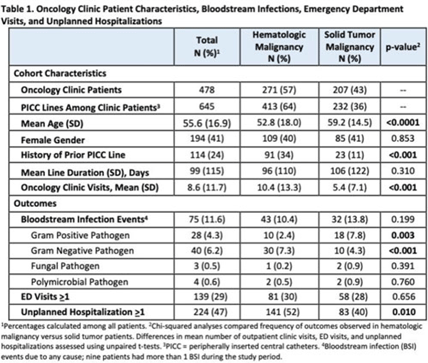174 results
Psychometric and adherence considerations for high-frequency, smartphone-based cognitive screening protocols in older adults
-
- Journal:
- Journal of the International Neuropsychological Society , First View
- Published online by Cambridge University Press:
- 20 September 2024, pp. 1-9
-
- Article
-
- You have access
- Open access
- HTML
- Export citation
Head and Neck Cancer: United Kingdom National Multidisciplinary Guidelines, Sixth Edition
-
- Journal:
- The Journal of Laryngology & Otology / Volume 138 / Issue S1 / April 2024
- Published online by Cambridge University Press:
- 14 March 2024, pp. S1-S224
- Print publication:
- April 2024
-
- Article
-
- You have access
- Open access
- HTML
- Export citation

Risks in Renaissance Art
- Production, Purchase, and Reception
-
- Published online:
- 11 January 2024
- Print publication:
- 21 March 2024
-
- Element
- Export citation
Bloodstream infection burden among cancer clinic patients with PICC Lines: A prospective, observational study
-
- Journal:
- Antimicrobial Stewardship & Healthcare Epidemiology / Volume 3 / Issue S2 / June 2023
- Published online by Cambridge University Press:
- 29 September 2023, p. s49
-
- Article
-
- You have access
- Open access
- Export citation
Raccoon rabies control and elimination in the northeastern USA and southern Québec, Canada
-
- Journal:
- Epidemiology & Infection / Volume 151 / 2023
- Published online by Cambridge University Press:
- 22 March 2023, e62
-
- Article
-
- You have access
- Open access
- HTML
- Export citation
Archives of Idi Amin
-
- Journal:
- History in Africa / Volume 48 / June 2021
- Published online by Cambridge University Press:
- 11 February 2022, pp. 413-427
-
- Article
- Export citation
A Veterans’ Healthcare Administration (VHA) antibiotic stewardship intervention to improve outpatient antibiotic use for acute respiratory infections: A cost-effectiveness analysis
-
- Journal:
- Infection Control & Hospital Epidemiology / Volume 43 / Issue 10 / October 2022
- Published online by Cambridge University Press:
- 29 September 2021, pp. 1389-1395
- Print publication:
- October 2022
-
- Article
- Export citation
Characterisation of age and polarity at onset in bipolar disorder
-
- Journal:
- The British Journal of Psychiatry / Volume 219 / Issue 6 / December 2021
- Published online by Cambridge University Press:
- 25 August 2021, pp. 659-669
- Print publication:
- December 2021
-
- Article
-
- You have access
- Open access
- HTML
- Export citation
Nonventilator hospital-acquired pneumonia: A call to action: Recommendations from the National Organization to Prevent Hospital-Acquired Pneumonia (NOHAP) among nonventilated patients
-
- Journal:
- Infection Control & Hospital Epidemiology / Volume 42 / Issue 8 / August 2021
- Published online by Cambridge University Press:
- 09 June 2021, pp. 991-996
- Print publication:
- August 2021
-
- Article
- Export citation
Reporting uncertainty in results—Response to article on copper cold-spray technology
-
- Journal:
- Infection Control & Hospital Epidemiology / Volume 43 / Issue 4 / April 2022
- Published online by Cambridge University Press:
- 18 May 2021, p. 537
- Print publication:
- April 2022
-
- Article
-
- You have access
- HTML
- Export citation
The Unseen Archive of Idi Amin: Making History in a Tight Corner
-
- Journal:
- Comparative Studies in Society and History / Volume 63 / Issue 1 / January 2021
- Published online by Cambridge University Press:
- 14 January 2021, pp. 5-40
-
- Article
-
- You have access
- Open access
- HTML
- Export citation
Enhancing Infection Prevention and Control Capacity in Health Facilities Following the 2019 Ebola Outbreak in Kasese, Uganda
-
- Journal:
- Infection Control & Hospital Epidemiology / Volume 41 / Issue S1 / October 2020
- Published online by Cambridge University Press:
- 02 November 2020, p. s471
- Print publication:
- October 2020
-
- Article
-
- You have access
- Export citation
VA Antibiotic Stewardship Intervention to Improve Outpatient Antibiotic Use for ARIs: A Cost-Effectiveness Analysis
-
- Journal:
- Infection Control & Hospital Epidemiology / Volume 41 / Issue S1 / October 2020
- Published online by Cambridge University Press:
- 02 November 2020, p. s55
- Print publication:
- October 2020
-
- Article
-
- You have access
- Export citation
Validation of the SHEA/IDSA severity criteria to predict poor outcomes among inpatients and outpatients with Clostridioides difficile infection
-
- Journal:
- Infection Control & Hospital Epidemiology / Volume 41 / Issue 5 / May 2020
- Published online by Cambridge University Press:
- 30 January 2020, pp. 510-516
- Print publication:
- May 2020
-
- Article
- Export citation
Response of ‘Russet Burbank’ Seed Tubers Containing Dicamba and Glyphosate
-
- Journal:
- Weed Technology / Volume 33 / Issue 1 / February 2019
- Published online by Cambridge University Press:
- 07 December 2018, pp. 9-16
-
- Article
- Export citation
Multi-Trait Analysis of GWAS and Biological Insights Into Cognition: A Response to Hill (2018)
-
- Journal:
- Twin Research and Human Genetics / Volume 21 / Issue 5 / October 2018
- Published online by Cambridge University Press:
- 13 July 2018, pp. 394-397
-
- Article
-
- You have access
- HTML
- Export citation
12 - When Do Religious Accommodations Burden Others?
- from Part III - Objecting to Antidiscrimination Laws in the Name of Mainstream Religious Convictions
-
-
- Book:
- The Conscience Wars
- Published online:
- 20 June 2018
- Print publication:
- 05 July 2018, pp 328-346
-
- Chapter
- Export citation
Contents
-
- Book:
- Modern Evolutionary Economics
- Published online:
- 21 April 2018
- Print publication:
- 03 May 2018, pp v-vi
-
- Chapter
- Export citation
Index
-
- Book:
- Modern Evolutionary Economics
- Published online:
- 21 April 2018
- Print publication:
- 03 May 2018, pp 263-272
-
- Chapter
- Export citation
Copyright page
-
- Book:
- Modern Evolutionary Economics
- Published online:
- 21 April 2018
- Print publication:
- 03 May 2018, pp iv-iv
-
- Chapter
- Export citation





